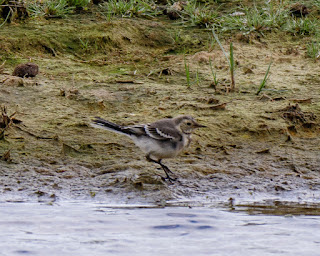We had a lot of rain overnight, but conditions improved and it was warm and sunny all morning, though a bit breezy it times. The AA sign posted car park was easy to find and it was only a short walk along a bridleway around the dis-used quarry to the view point. Two Bee-eaters were perched up on a distant tree, and another three to four were in a dead bush on the banks of a small lake. All the time we were there at least five birds were on view, either perched or flying around hawking for insects. To say the views were excellent would be an understatement and we had a very enjoyable time, spoilt only by one or two guys with big lenses who had to block others views. Well worth the fiver for the car parking.
Cant really say how many birds are currently there-reports suggest seven, but there are supposed to be three nest holes (which are not viewable) and I di=ont know how successful they have been.
After a very enjoyable morning we headed off to RSPB Frampton Marsh for the afternoon. Weather was a bit mixed with a lot more cloud and the occasional light shower but again very enjoyable.
At first it didn't seem all that promising as a lot of the scraps seemed rather dry and empty apart from cows and Avocets with huge numbers of hirundines-mainly Sand Martins feeding over the reeds. We headed off down the road to the sea wall where a small crowd could be seen in the distance, and presumably where the good birds were.
The large expanse of muddy pools inland from the wall was covered in waders-large flocks of Godwits, Redshank, Ruff and Dunlin, half a dozen Spotted Redshanks, some Curlew Sandpipers, Ringed and Little Ringed Plovers, two Little Stints and a rather elusive Pectoral Sandpiper tucked into a clump of sedge. On the salt marsh some Curlews and Whimbrels were hard to pick up.
From the East Hide, many more godwits, shanks, stints, Common and Wood Sandpiper and four or five Knot. Among the hoards of Little Egrets were two Spoonbills.
Walking back to the 360 hide a photographer had stopped-showed me the back of the camera and asked me to identify his photos-a juvenile Cuckoo. Unfortunately it had flown some way and although I got good scope views my photos were rather poor.
In the 360 hide we got better views of the egrets, the Knot, some flyover Snipe and a somewhat unexpected Whooper Swan that presumably injured had over summered. We had been seeing family parties of Yellow Wagtails from the sea walls and managed to get decent but distant views of some of the juveniles on one of the islands. Weirdly despite the large variety of waders present, Oystercatcher Turnstone and Sanderling, always expected around the Wash, seemed to be absent.










